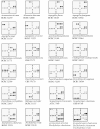Rapid identification of allergenic and pathogenic molds in environmental air by an oligonucleotide array
- PMID: 21486490
- PMCID: PMC3100263
- DOI: 10.1186/1471-2334-11-91
Rapid identification of allergenic and pathogenic molds in environmental air by an oligonucleotide array
Abstract
Background: Airborne fungi play an important role in causing allergy and infections in susceptible people. Identification of these fungi, based on morphological characteristics, is time-consuming, expertise-demanding, and could be inaccurate.
Methods: We developed an oligonucleotide array that could accurately identify 21 important airborne fungi (13 genera) that may cause adverse health problems. The method consisted of PCR amplification of the internal transcribed spacer (ITS) regions, hybridization of the PCR products to a panel of oligonucleotide probes immobilized on a nylon membrane, and detection of the hybridization signals with alkaline phosphatase-conjugated antibodies.
Results: A collection of 72 target and 66 nontarget reference strains were analyzed by the array. Both the sensitivity and specificity of the array were 100%, and the detection limit was 10 pg of genomic DNA per assay. Furthermore, 70 fungal isolates recovered from air samples were identified by the array and the identification results were confirmed by sequencing of the ITS and D1/D2 domain of the large-subunit RNA gene. The sensitivity and specificity of the array for identification of the air isolates was 100% (26/26) and 97.7% (43/44), respectively.
Conclusions: Identification of airborne fungi by the array was cheap and accurate. The current array may contribute to decipher the relationship between airborne fungi and adverse health effect.
Figures


Similar articles
-
Identification of medically important molds by an oligonucleotide array.J Clin Microbiol. 2005 Aug;43(8):3760-8. doi: 10.1128/JCM.43.8.3760-3768.2005. J Clin Microbiol. 2005. PMID: 16081907 Free PMC article.
-
Development of an oligonucleotide array for direct detection of fungi in sputum samples from patients with cystic fibrosis.J Clin Microbiol. 2009 Jan;47(1):142-52. doi: 10.1128/JCM.01668-08. Epub 2008 Nov 19. J Clin Microbiol. 2009. PMID: 19020057 Free PMC article.
-
High-throughput identification of clinical pathogenic fungi by hybridization to an oligonucleotide microarray.J Clin Microbiol. 2006 Sep;44(9):3299-305. doi: 10.1128/JCM.00417-06. J Clin Microbiol. 2006. PMID: 16954264 Free PMC article.
-
DNA and the classical way: identification of medically important molds in the 21st century.Med Mycol. 2007 Sep;45(6):475-90. doi: 10.1080/13693780701449425. Med Mycol. 2007. PMID: 17710617 Review.
-
Utilization of the internal transcribed spacer regions as molecular targets to detect and identify human fungal pathogens.Med Mycol. 2002 Feb;40(1):87-109. doi: 10.1080/mmy.40.1.87.109. Med Mycol. 2002. PMID: 11860017 Review.
Cited by
-
Identification of fungal pathogens by visible microarray system in combination with isothermal gene amplification.Mycopathologia. 2014 Aug;178(1-2):11-26. doi: 10.1007/s11046-014-9756-2. Epub 2014 Jun 22. Mycopathologia. 2014. PMID: 24952715 Free PMC article.
-
Isolation and drug susceptibility of Candida parapsilosis sensu lato and other species of C. parapsilosis complex from patients with blood stream infections and proposal of a novel LAMP identification method for the species.Mycopathologia. 2015 Feb;179(1-2):53-62. doi: 10.1007/s11046-014-9830-9. Epub 2014 Dec 7. Mycopathologia. 2015. PMID: 25481844
-
PCR-Based Microarray Enhances Diagnosis of Culture-Negative Biopsied Tissue in Patients with Invasive Mold Infections: Real-World Experience in a Tertiary Medical Center.J Fungi (Basel). 2024 Jul 29;10(8):530. doi: 10.3390/jof10080530. J Fungi (Basel). 2024. PMID: 39194856 Free PMC article.
-
Comparison of DNA Microarray, Loop-Mediated Isothermal Amplification (LAMP) and Real-Time PCR with DNA Sequencing for Identification of Fusarium spp. Obtained from Patients with Hematologic Malignancies.Mycopathologia. 2017 Aug;182(7-8):625-632. doi: 10.1007/s11046-017-0129-5. Epub 2017 Mar 21. Mycopathologia. 2017. PMID: 28324245
-
Comparison of the BluePoint MoldID oligonucleotide array and Bruker Biotyper MALDI-TOF MS for the identification of filamentous fungi.J Clin Microbiol. 2025 Jan 31;63(1):e0104824. doi: 10.1128/jcm.01048-24. Epub 2024 Dec 5. J Clin Microbiol. 2025. PMID: 39636116 Free PMC article.
References
Publication types
MeSH terms
Substances
LinkOut - more resources
Full Text Sources
Medical

